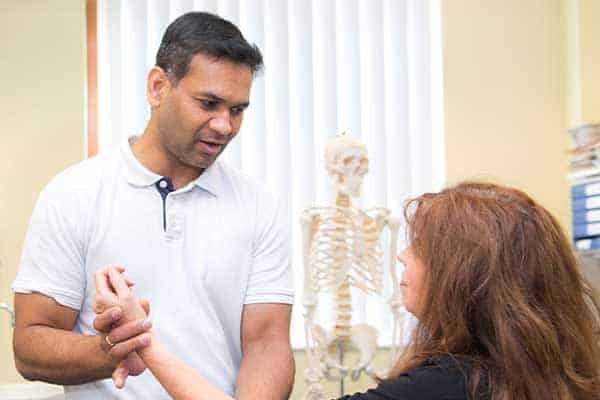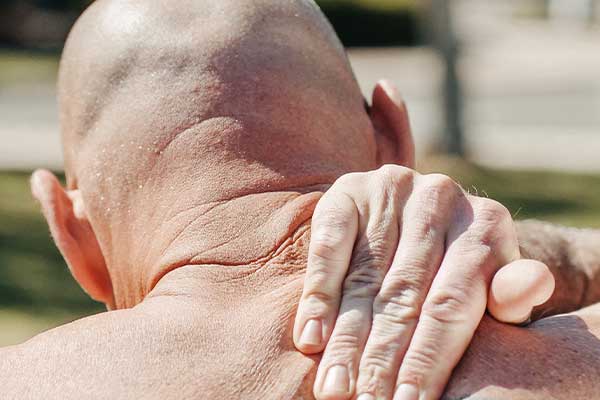Mechanical neck pain is general neck pain that cannot be attributed to a specific issue with a particular part of your neck. This is very common, but its effects can vary greatly from person to person.
What causes mechanical neck pain?
Typically, mechanical neck pain does not start with a significant trauma like a fall or an impact. It might come on suddenly, for example when you lift something or hold your neck in an awkward position, or it might build up gradually with no obvious cause.
Although your pain may have its origins in a previous injury, there could be a number of other factors contributing to it. These can range from the health of your tissues and joints to issues relating to age, genetics, diet, sleep and stress.
What are the symptoms of mechanical neck pain?
For most people:
- The pain is localised in your neck.
- The pain causes reduced range of movement.
- It is a dull, aching pain that may become sharp when you move.
For some people:
- You may also feel referred pain in your shoulder or upper back.
How is mechanical neck pain diagnosed?
Your doctor might diagnose mechanical neck pain if your symptoms do not point to a problem with a particular structure such as a joint, ligament or disc.
What are the treatment options for mechanical neck pain?
Mechanical neck pain will usually go away by itself. However, you can help to make this happen.
The first thing to remember is that your neck and your spine are strong, stable structures and you will not damage them by moving. Being afraid to move is a natural reaction to pain but it can make the problem worse or stop it from resolving itself.
Try to keep moving your neck normally. You could try some simple stretching and mobility exercises to gain confidence and gradually increase your range of movement. Although it may cause more pain at first, this is not a bad sign and your neck should soon become less sensitive. Research indicates that you are much more likely to make a quick recovery if you avoid the urge to rest your neck for long periods of time.
You could also apply gentle heat or ice, which can help to manage the pain. (Do not put ice directly next to skin as it may cause ice burn. Wrap it in a damp tea towel.)
Paracetamol-based painkillers can help by enabling you to continue with your normal activities. Anti-inflammatory painkillers such as Ibuprofen can also be helpful in reducing pain. Ask your doctor or pharmacist for advice.
What is the prognosis (outlook) for mechanical neck pain?
Mechanical neck pain tends to clear up within six weeks. If it does not, you are advised to visit your GP for further examination.
If your symptoms persist, your GP may recommend manual therapy/manipulation. This can help to relieve pain by decreasing muscle spasm, stiffness and inflammation. It can also improve the mobility of your neck joints and your posture to help prevent neck pain in the future.
In a small minority of cases, neck pain can indicate a more serious condition. If you have any concerns, check the symptoms on our serious neck pain page.
How can I prevent recurrence of mechanical neck pain?
It is advisable to stand up and change your position regularly, whether you are resting or at work. While it is always a good idea to think about your posture and whether or not it is causing discomfort, generally it is sustaining a posture for too long that is bad for you.
In the longer term, performing regular stability and strengthening exercises could help to reduce the chance of further episodes of mechanical neck pain.
Also, always pay attention to your lifting and carrying techniques. Keep objects close to your body. Use your knees and keep your back straight when lifting. Carry similar loads in each hand to avoid leaning and always try to move your feet to turn, rather than twisting your spine.”
Recommended exercises (click to expand):
Neck flexion, extension, sidebending and rotation
- Sit up straight with your shoulders back and down, looking straight ahead.
- Tilt your head to look down towards the floor.
- Tilt your head to look up towards the ceiling.
- Turn your head to look over your right shoulder.
- Turn your head to look over your left shoulder.
- Move your right ear towards your right shoulder.
- Move your left ear towards your left shoulder.
- Keep your shoulders down at all times.
Towel extension
- Sit in an upright chair with a medium-long rolled-up towel behind your neck and the ends in your hands.
- Tilt your head to look up towards the ceiling and at the same time pull forwards away from you on the ends of the towel.
- Repeat this extension or move the towel slightly upwards or downwards on your neck to find different points to stretch at.
Towel rotation
- Sit in an upright chair with a short rolled-up towel behind your neck and the ends on your chest.
- Take the left end of the towel in your right hand and the right end in your left.
- Hold your hands up in front of your neck (now your hands are not crossed over but the towel ends are).
- Rotate your head to the right while moving your right hand in the same direction, pulling the towel tight.
- Gently turn your head and right hand back and forth to the right. Your left hand should stay still.
- Repeat on the other side.
Neck retraction
- Kneel on all fours with your hands below your shoulders and your knees below your hips. Find a neutral position for your spine and head, looking down between your hands.
- Push the heels of your hands into the floor, making your shoulder blades flatten against your back.
- Gently press your tongue into the roof of your mouth and imagine a string attached to the back of your head, pulling it up.
- Keeping your head level and your gaze between your hands, move your head upwards until you make a double chin.
- Hold this position. Relax and repeat.
- Ensure that your back and neck stay in the neutral position.
Isometric neck
- Sit on an upright chair or stool, looking straight ahead.
- Place the palm of one hand against your forehead, then gently push your head against your hand and hold.
- Place your hand on the back of your head, push your head against your hand and hold.
- Place your hand on the side of your head, gently push your head against your hand and hold.
- Place your other hand on the other side of your head, gently push your head against your hand and hold.
Wall press up
- Face a wall and stand up straight, then take one step back.
- Place your hands flat against the wall, with your arms around shoulder height and your hands slightly wider than your shoulders.
- Tighten your buttock muscles.
- Keeping your body in a straight line from your feet to the top of your head, bend your elbows and move your chest towards the wall.
- Straighten your arms again to lift your chest away from the wall.
- Repeat this exercise.





